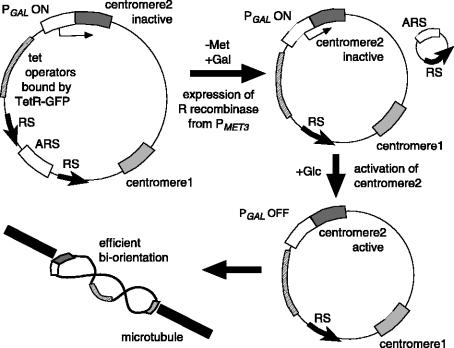Figure 2.
The process of generating an unreplicated dicentric circular minichromosome (Dewar et al. 2004) is illustrated. ARS, DNA replication origin; RS, recombination site; PMET3, MET3 promoter; PGAL, GAL1-10 promoter; Met, methionine; Gal, galactose; Glc, glucose. The original minichromosome had two centromeres; one (centromere 1) was constitutively active, and the other (centromere 2) was conditionally inactivated owing to its juxtaposition to the GAL1-10 promoter (Hill & Bloom 1987). The chromosome also possessed a single replication origin flanked by recombination sites for the R recombinase (Matsuzaki et al. 1990). The R recombinase was conditionally expressed from the MET3 promoter that is turned on in the absence of methionine. To visualize the behaviour of this minichromosome, we integrated a tandem array of tet operators that bind Tet repressor–GFP fusion proteins (Michaelis et al. 1997). The minichromosome was stably propagated as long as cells were grown without expression of the R recombinase and the centromere 2 was maintained inactive. To obtain an unreplicated dicentric chromosome, we first removed the replication origin on the minichromosome by expressing the R recombinase. Then, we activated the centromere 2 by turning off the adjacent GAL1-10 promoter.

